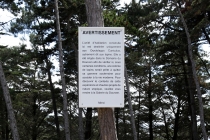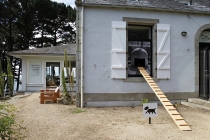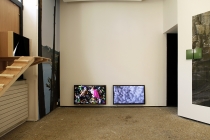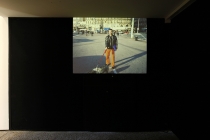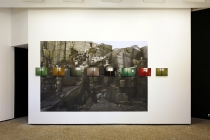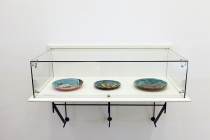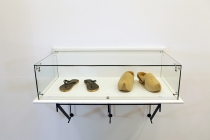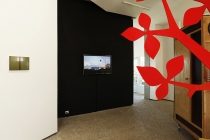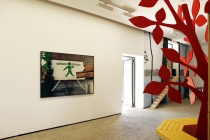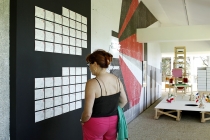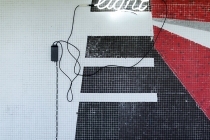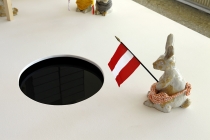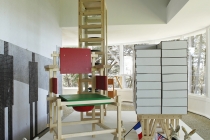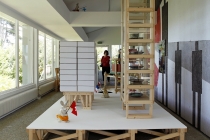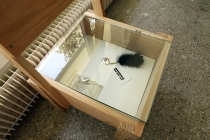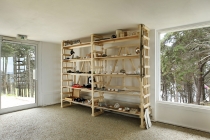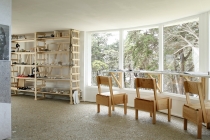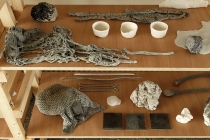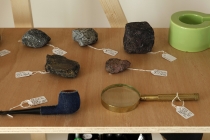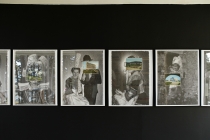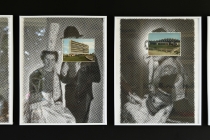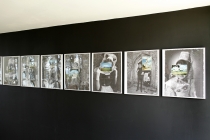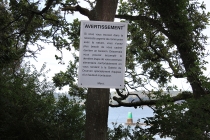21st June until 5th November 2014.
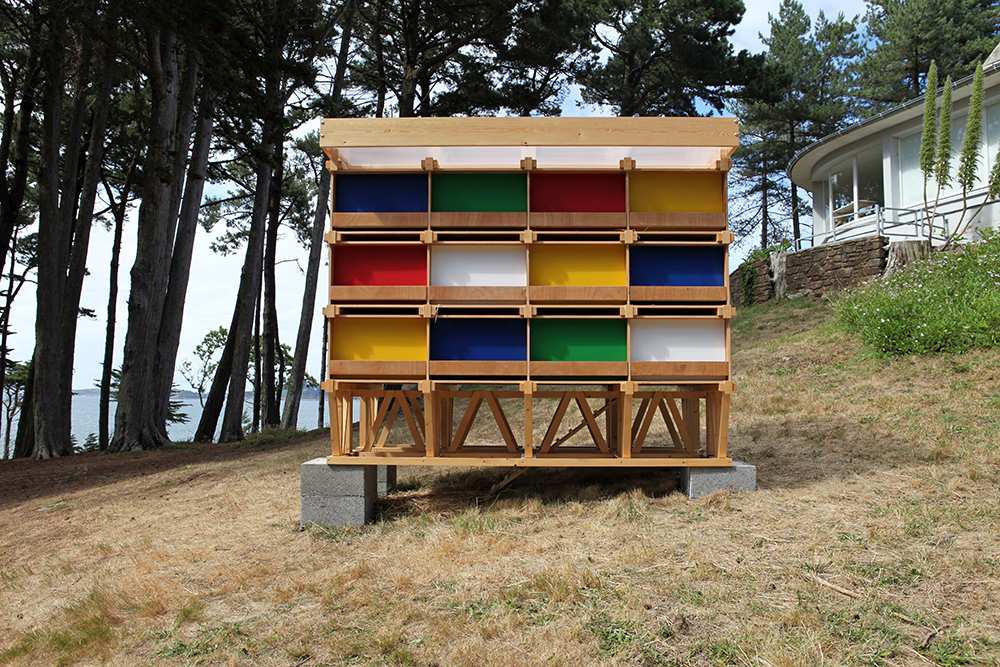
British artist based in France, David Michael Clarke plays around combining art works with everyday situations. Through both human and artistic encounters and through a thought process on overdrive, he twists and turns, arranges, appropriates, multiplies and mixes different cultural registers, be they «high», or be they «pop». He is particularly, and not without malice, fond of manipulating meaning, playing between the culture of his native country and that of his adopted home. Investigating language and playing with words is often the starting point of artistic projects that can take the form of objects or events that he takes care to integrate into many different contexts. This attention to a context beyond the art world leads Clarke to «live-in-residence» and create moments of conviviality.
In 2011, David Michael Clarke discovered the project for a «village radieux» imagined in the 1930’s by the architect Le Corbusier for the village Piacé (Sarthe). Le Corbusier’s project for a «radieux» farm and village were much of the same order as the «cité radieuse» constructed in Marseille and Rezé. This urban programme based on the concept of the «unit» (living unit, collective unit, industrial unit, agricultural unit, rural unit) is born of a global vision for urban and territorial planning. In Piacé, the architect chose to break with the isolation of farmers through the creation of a space dedicated to social discussion. This building, placed at the heart of the village is known as the «Club». Le Corbusier considered it to be the «brain» of the village.
In 2012, crossing the Mayenne region, David Michael Clarke came across an agricultural protest. The farmers expressed their anger by erecting six gallows from which images of cows’ heads, cut out from carton, were hanging. Like kites, the cows’ heads flew in the wind. David Michael Clarke announced out loud, «Wow! Flying Black Cows!» Later that year, in the context of a rural contemporary art festival, in the village of Fiac (Tarn), the artist made his first «Flying Black Cows». Also cut our from carton, these archetypal black cows took off, carried into the air by giant coloured ballons filled with helium.
In 2013, David Michael Clarke obtained an artist’s residency at Lycée Félix Le Dantec (Lannion). The coastal context is for him the occasion to envisage a new version of the «Flying Black Cows». Thus he borrows the form of the cow’s head from the french farmers and learns how to make kites. The cows fly and pass furtively before the spires of the «Beaumanoir» churches that dress the Trégor skyline and are sculpted by the wind. Their apparitions are filmed by the artist. In October of the same year, he participates in the festival «Vent de Grève», organized by the local office of tourism, and for which he conceives the «Flying Black Cow Cinema». On the long beach of Saint-Efflam, he sets up an ex-army tent surmounted by a sign, to house his cinema and to present the video that he had made that summer in the Trégor region.
In 2014, invited to exhibit in the Galerie du Dourven, he decides to transform the art centre into the «Flying Black Cow Utopia Club». During his many visits to the Dourven in 2013, he remarks upon the park’s regular frequentation by individuals that, through their activities, seemed to him, to form communities. Apart from week-end visitors and holiday-makers, four groups stood out, that of wedding couples and their photographers; that of the fishermen who traverse the park, rod in hand, according to the tides; that of the dogs and dog-walkers; and that of the rabbits, who in the evening rediscover their tranquillity. «Flying Black Cow Utopia Club» renders visible these different users and brings to light these fictional communities in an installation that mixes art and design, popular references and artistic gestures.
Après ce premier volet consacré aux communautés qui peuplent la pointe du Dourven, David Michael Clarke poursuit son travail à la galerie du Dourven en invitant de nouvelles figures historiques et contemporaines, amplifiant ainsi ce qui caractérise sa démarche plastique selon quatre modalités.
After the first exhibition, which concentrated on the communities that use the park, David Michael Clarke follows through on his work at the Galerie du Dourven by inviting new figures, both historic and contemporary, amplifying that which has come to characterize his art practice following four modalities.
The first is the creation or inclusion of works in relation to the site, like the Wooden tree, Rabbits & Dogs, Fish Hotel, Flying Black Cow (video), the Habitation unit for 24 rabbits, Guillaume Janot, Fédérica Peyrolo, Christelle Familiari, Anabelle Hulaut and David Liaudet.
The second consists of reactivating works from his own repertory or that of other artists, such as DMC Light.
The third is to demand the loan of works from other artists or institutions and to explain the nature of the exhibition, such as with Mademoiselle Hulaut’s cabin and works by Norbert Bézard, François Curlet, Francesco Finizio, Joël Hubaut, Nicolas Hérisson, Paul Pouvreau, Christophe Terlinden.
Finally the fourth, David Michael Clarke allows himself to intervene in borrowed works having obtained permission where necessary from the concerned artists, such as Kennel (La ricarda) by Michel François, Carré Central by Hervé Beurel, or the chairs by Enzo Mari and Gerrit Rietveld.
This pratice, that one could call collaborative, does not proceed without interrogating the question of the author, the statute of the artist, and the artistic nature of such a project.
Even if the dog-walkers, the fishermen and the rabbits are still present in this second exhibition, David Michael Clarke offers a special hommage to the local architect, Roger Le Flanchec. Profoundly inspired by the work of Le Corbusier, Roger Le Flanchec is known for the building «Hélios» in the town of Trébeurden, the only example of an Habitation unit constructed in France following the model of the «cité radieuse», with the exception of those constructed by Le Corbusier himself. In this historic period, the 1930’s, the workers’ struggles to attain this utopia, such as paid leave, lead to the birth of the «seaside» that we know today as much through the architectural traces as the marks left upon human behavior.
Didier Lamandé
List of Works
1 – Michel François, Kennel (La ricarda), 2007, poster 180×120 cm adapted by David Michael Clarke through the addition of two ramps and a tunnel to allow for the passage of dogs, 2014
2 – Hervé Beurel, Carré central, digital wallpaper, 2014 adapted by David Michael Clarke through partial suppression.
3 – Federica Peyrolo, Sorpressata, 2014, Video Hd Coulour, 10’29 min.
4 – Federica Peyrolo, Fragile, 2014, Video Hd, Coulour, 10’29 min.
5 – Guillaume Janot, Untitled, Tableau 1, 2014, mural photograph and c-type photographs mounted on aluminium, variable dimensions.
6 – Anabelle Hulaut & David Michael Clarke, Cabane for Melle Hulaut, 2002. Inside, video by Anabelle Hulaut, Les vacances de Melle Hulaut, 2002 extract, sequence «Fishing by Foot» Coutainville.
7 – David Michael Clarke, Wooden Tree, installation, 2014.
8 – Paul Pouvreau, La Coupe, 1996, c-type photograph, mounted on aluminium, 113 x 154 cm, Collection Frac Normandie Caen.
9 – Norbert Bézard, three plates Barbier Monaco, Mouette rieuse, Papillon, 1953.
10 – François Curlet, Saboosh, 2008, pyro-engraved cloggs, 12,5 x 33 x 13 cm chacun, private collection.
11 – Christophe Terlinden, Flip-Flops, bronze, private collection.
12 – David Michael Clarke, Flying Black cow, video HD 16/9, 2012.
13 – Francesco Finizio, Walking the dog, promenades plastiques 1998, diaporama, 16 min.
14 – David Michael Clarke, DMC Light, 2004, neon, postcards and c-type photograph mounted on aluminium. Variable dimensions.
15 – Hervé Beurel, Carré central, digital wallpaper, 2014 adapted by David Michael Clarke through partial suppression and by the superposition of the work, DMC light.
16 – David Michael Clarke, Fish Hotel, installation in the gallery and in the park, wood, bassin, sign, 2014.
17 – David Michael Clarke, Habitation unit for the happy couples, 2014, Today mariages, England and Wales, 1969-1999, archived in 53 boxes, wooden structure (hommage to Neal Beggs, Enzo Mari, and to Le Corbusier).
18 – Joël Hubaut, Rabbit Generation , 1994, seven ceramic rabbits, modified by the addition of a «modesty-belt» made by Christelle Familiari.
19 – David Michael Clarke, Rietveld Montauban, 2014, High back chair by Gerrit Rietveld adapted by the addition of a bassin and a sign in the park.
20 – François Curlet, La Corbu, fishing spoon. Plan de La Ferme Radieuse, logotype and printed on the palette of a spoon aglia classique n°5, assembled with a simple hook.
21 – François Curlet, La V.i.p, fishing spoon, motif black lipstick trace, black feathers.
22 – Nicolas Hérisson, re-edition of a «chapelle de ronchamp» plate by Norbert Bézard, Piacé le radieux, 2013.
23 – Centre de documentation proposed by David Michael Clarke, artists’ catalogues, other reference material, chairs by Enzo Mari.
24 – David Liaudet.
25 – Christelle Familiari, Shelves, 2014, ensemble of sculptures.
26 – Anabelle Hulaut, Collection Sam Moore, 2013-2014, various objects.
27 – David Michael Clarke, Habitation unit for 24 rabbits, 2014, specific objetin wood, sign.
28 – David Michael Clarke, Flying Black Cow Club, cement sculpture, 43x35x13,5 cm, 2013.
Social Housing for 24 Rabbits
Rietveld Montauban
Flying Black Cow Video (HD version)
DMC Light
Flying Black Cow Utopia Club (Volet #01)
Texte (French) : Marie-Line Nicol
Texte (French) : Sandra Flouriot
Links
Michel François chez Kamel Mennour
Hervé Beurel sur DDAB
François Curlet website
Christelle Familiari website
Francesco Finizio sur Documents d’Artistes
Joël Hubaut website
Anabelle Hulaut website
Guillaume Janot website
David Liaudet blog
Federica Peyrolo website
Paul Pouvreau dans la collection du FRAC Normandie Caen
Piacé-le-Radieux

